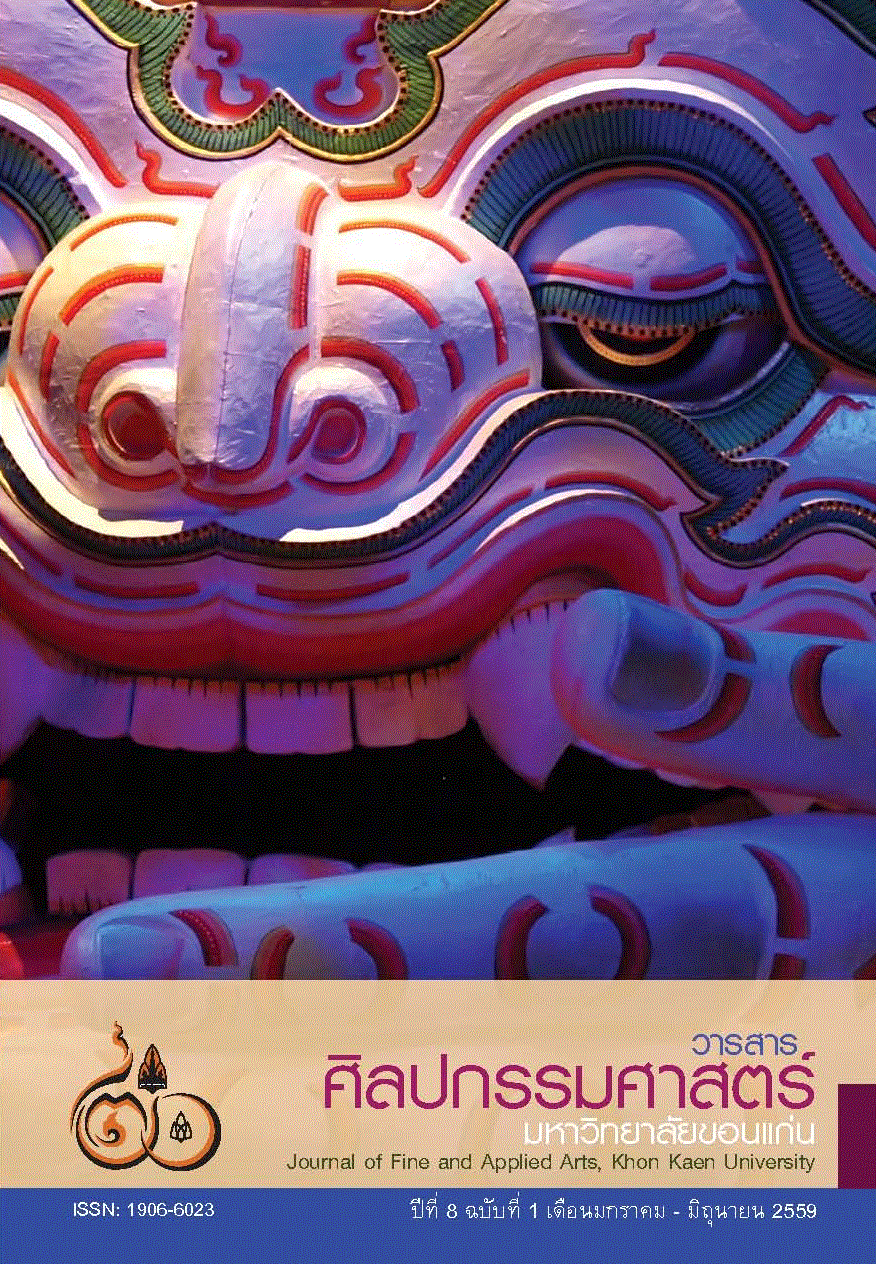การออกแบบและพัฒนาบรรจุภัณฑกันกระแทกจากเศษกระดาษ Design and Development of Resistant Packaging types from Scrap Paper
Main Article Content
Abstract
การวิจัยเกี่ยวกับการออกแบบและพัฒนาบรรจุภัณฑชนิดกันกระแทกจาก เศษกระดาษโดยมีวัตถุประสงค 3 ประการ คือ 1) ศึกษาและวิเคราะหขอมูลปริมาณ และชนิดของเศษกระดาษเพื่อนํามาทดลองและพัฒนาเปนบรรจุภัณฑกันกระแทก 2) ศึกษาและวิเคราะหผลิตภัณฑที่ตองการใชบรรจุภัณฑกันกระแทก 3) เพื่อ ออกแบบและพัฒนาบรรจุภัณฑกันกระแทกโดยการศึกษาวิจัยมุงเนนที่จะออกแบบ และพัฒนาบรรจุภัณฑกันกระแทกใหเหมาะสมและสอดคลองกับผลิตภัณฑที่มีความ ตองการใชงานตลอดจนเปนการเพิ่มมูลคาและลดอัตราการสูญเสียในการขนสง สําหรับผลิตภัณฑที่มีความเปราะบางและแตกหักงาย การศึกษาวิจัยนี้เปนการศึกษาวิจัยเชิงคุณภาพและการวิจัยเชิงทดลอง กลุมประชากรกลุมตัวอยางที่ใชในการศึกษาวิจัยครั้งนี้คือ ผูประกอบการเกี่ยวกับ การผลิตเครื่องปนดินเผาและผลิตงานเซรามิกในจังหวัดอุบลราชธานีซึ่งไดจากการ สุมตัวอยางแบบเจาะจง จากผลการศึกษาวิจัยพบวา การสํารวจปริมาณเศษกระดาษที่เหลือจาก การผลิตและการใชงานในโรงพิมพและหนวยงานตางๆมีปริมาณเศษกระดาษโดย เฉลี่ยไมนอยกวา 50 กิโลกรัมตอวันตอหนวยงาน โดยผูวิจัยไดคัดแยกคุณสมบัติของ เศษกระดาษชนิดตางๆ ออกเปน 3 กลุมคือ เศษกระดาษที่ไมปนเปอนหมึก เศษกระดาษที่ปนเปอนหมึก และเศษกระดาษที่ปนเปอนหมึกและสารเคลือบผิว ใน การนี้ไดใชกระบวนการทดลองในการคัดแยกเพื่อคนหาลักษณะของเนื้อเยื่อกระดาษ ที่เหมาะสมกับการนําไปใชในการพัฒนาเปนบรรจุภัณฑกันกระแทกซึ่งพบวา เศษกระดาษที่ไมปนเปอนหมึกและเศษกระดาษที่ปนเปอนหมึกมีความเหมาะสมมาก ที่สุด โดยใชสูตรการผสมเศษกระดาษที่ไมปนเปอนหมึก 5 สวนผสมกับเศษกระดาษ ที่ปนเปอนหมึก 4 สวนบดผสมใหเปนเนื้อเดียวกันแลวนําไปผสมกับเสนใยกลวยโดย ใชอัตราสวนในการผสมเปน เนื้อเยื่อกระดาษ 5 สวนเสนใยกลวย 3 สวนบดผสมให เปนเนื้อเดียวกันแลวนําไปเทและกดเนื้อเยื่อกระดาษลงในแมพิมพชั้นนอกและแม พิมพชั้นในหลังจากนั้นนําเนื้อเยื่อกระดาษไปทดสอบคุณสมบัติเบื้องตน ซึ่งประกอบ ดวยการทดสอบคุณสมบัติของเนื้อเยื่อกระดาษเกี่ยวกับการซึมซับนํ้า การทนตอแรง กด การทนตอแรงดึง ผลการทดสอบพบวา เนื้อเยื่อกระดาษผานการทดสอบโดยรวม ไดในระดับดีมาก หลังจากนั้นจึงนําไปทดสอบคุณสมบัติเชิงกลโดยใชเครื่องทดสอบ การกระแทก (Impact Testing Machine) พบวา เนื้อเยื่อกระดาษสามารถตานแรง กระแทกโดยรวมไดในระดับดีมากไดสรุปผลการทดสอบ 2 ประเด็นคือ 1) การทดสอบบรรจุภัณฑกันกระแทกชั้นนอกพบวา บรรจุภัณฑสามารถ ตานแรงกระแทกไดในสภาวะที่เหมาะสมนํ้าหนักการกระแทกที่ 0.5 กิโลกรัมความ สูงของการกระแทกคือ 0.5 เมตร จะรองรับนํ้าหนักและรับแรงกระแทกไดไมเกิน 20 กิโลกรัม ตอจุดที่ถูกกระแทก 2) การทดสอบบรรจุภัณฑกันกระแทกชั้นในพบวา บรรจุภัณฑสามารถตานแรงกระแทกไดในสภาวะที่เหมาะสมนํ้าหนักการกระแทกที่ 0.5 กิโลกรัมความสูงของการกระแทกคือ 0.5 เมตร จะรองรับนํ้าหนักและรับแรง กระแทกไดไมเกิน 10 กิโลกรัม ตอจุดที่ถูกกระแทก ผลจากการทดลองและทดสอบวัสดุ ผูวิจัยไดนํามาใชในการออกแบบ เปนบรรจุภัณฑกันกระแทกทั้งบรรจุภัณฑชั้นในและบรรจุภัณฑชั้นนอกโดยทดลอง ใชกับกลุมผลิตภัณฑเครื่องปนดินเผาและงานเซรามิกในเขตพื้นที่จังหวัดอุบลราชธานี
This research to design and development of cushioning packaging from waste paper that the three main objectives. 1) study and analyze the quantity and type of paper in order to try and develop the packaging cushions. 2) study and analysis that will be used packaging cushions. 3) design and develop to package cushioning the study focused on design and development, packaging, cushioning to suit the needs of cushioning products, as well as to add value and reduce losses. Transport for products that are fragile and easily broken.This study is a qualitative and experimental research study that the population sample used in this study is the operator on the production of pottery and ceramic in the Ubonratchathani provinces which were obtained from the sampling. This study is a qualitative research study and experimental research. The population in this study is the operator on the production of pottery and ceramic production in the UbonRatchathani provincethree groups. The results showed that the amount of paper left over from the production and use in printing, paper and other agencies were on average not less than 50 kg per day per unit.After analyzing the properties of waste paper sorting different types of waste such as paper, ink, paper is not contaminated, contaminated ink and paper scraps contaminated ink and coating. By screening for tissue paper to fi nd the right pieces of paper, ink and paper debris does not contaminate contaminated ink is the most feasible.The formulation Scrap paper is not contaminated ink5ingredients contaminated with waste paperink mixing 4 parts homogeneous, then mixed with banana fi bers.The ratio of the mixture into paper tissues 5 part 3 of banana fi bers mixed into a homogeneous, then poured into molds and pressed paper outer and inner mold. After the tissue paper to test the basic features, such as the absorption of water to withstand the pressure, the tensile strength. The test results showed that the tissue paper through the overall test was very good then, to test the mechanical properties by using shock test (Impact Testing Machine) tissue paper can withstand shocks, have very good confi dence which test results are two important ways. First, testing, packaging, cushioning layer outside the packaging can withstand shocks in optimum condition, weight, cushioning, 0.5 kg of the height of the bumps is 0.50 meters to support the weight and impact up to 20 kg per point.Second, testing, packaging, cushioning layer in the packaging can withstand shocks in optimum condition, weight, cushioning, 0.5 kg of the height of the bumps is 0.50 meters to support the weight and impact up to10 kg per point. The results of the experiment and the researchers have tested the material used in the design of packaging, packaging, cushioning the inner and outer packaging by product groups experiment with pottery and ceramics in UbonRatchathani province.
Article Details
Content and information in articles published in the Journal of Fine and Applied Arts of Khon Kaen University is regarded as the opinion and sole responsibility of the author(s) directly; therefore, editors are not obliged to agree to or share any responsibility with regard to the content and information that appears within these articles.
All articles, information, content, image, etc. that have been published in the Journal of Fine and Applied Arts of Khon Kaen University is the copyright of the Journal of Fine and Appllied Arts of Khon Kaen University. Any person or organization who wishes to distribute all or parts of the articles for further dissemination or other usage must first receive permission from the Journal of Fine and Applied Arts of Khon Kaen University before proceeding to do so.


